Dalai Lama opens Tibetan Pavilion at FACT Museum
@@NEWS_SUBHEADLINE_BLOCK@@
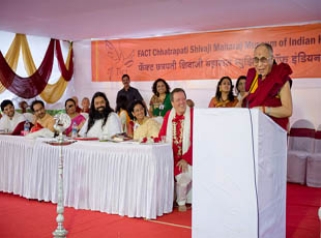 -Virag Pachpore
-Virag Pachpore
Pune, August 6: Underlining the Indian concept of non-violence and the philosophy supporting it, the Tibetan Spiritual Leader His Holiness Dalai Lama recently stressed on adopting the path of non-violence more seriously.
The Tibetan leader was speaking after inaugurating the Tibetan Pavilion at the Chhatrapati Shivaji Maharaj Museum of Indian History at Wadgaon Shinde near Lohegaon on Sunday, July 28. The pavilion showcases an exhibition of text and photographs depicting the trials and travails of Tibetan community over the last six decades.
Another exhibition on Dara Shikoh, elder brother of Aurangzeb, who had come very close to the understanding the Hindu philosophical thought in this life time and had translated the Hindu scriptures like Geeta in Persian; and who was killed by the power-hungry and fundamentalist Aurangazeb, was also inaugurated at the same venue.
Describing violence as a sign of weakness and non-violence a sign of strength and self-confidence, Dalai Lama said that this century should be celebrated as the century of peace.
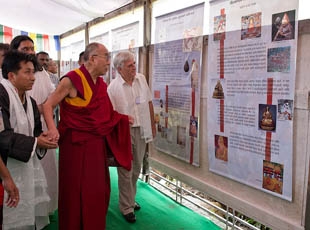 “We as human beings create problems by our wrongdoings and then seek God’s interference in resolving them. This is absolutely absurd because even God is helpless in solving the issues we create”, the Tibetan Spiritual leader stressed emphasizing the need to find out solutions to the problems created by “our own” actions.
“We as human beings create problems by our wrongdoings and then seek God’s interference in resolving them. This is absolutely absurd because even God is helpless in solving the issues we create”, the Tibetan Spiritual leader stressed emphasizing the need to find out solutions to the problems created by “our own” actions.
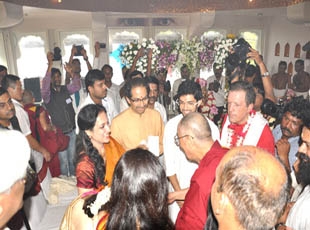 Shiv Sena Executive President Uddhav Thackeray and Sena’s youth wing chief Aditya Thackeray opened a unique miniature painting exhibition on Maharana Pratap on this occasion. Noted singer Vikram Hazara presented a short and melodious concert during the function.
Shiv Sena Executive President Uddhav Thackeray and Sena’s youth wing chief Aditya Thackeray opened a unique miniature painting exhibition on Maharana Pratap on this occasion. Noted singer Vikram Hazara presented a short and melodious concert during the function.
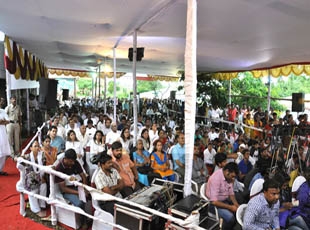 The Chhatrapati Shivaji Maharaj Museum of Indian History, which houses the Tibetan Pavilion—the latest addition to its already existing pavilions of exhibition showcasing important milestones of Indian history—is the brainchild of a Frenchman. Francois Gautier, a journalist by profession is the name of this Frenchman who has fallen in love with Mother India the moment he stepped on this land at the tender age of 19 from Paris.
The Chhatrapati Shivaji Maharaj Museum of Indian History, which houses the Tibetan Pavilion—the latest addition to its already existing pavilions of exhibition showcasing important milestones of Indian history—is the brainchild of a Frenchman. Francois Gautier, a journalist by profession is the name of this Frenchman who has fallen in love with Mother India the moment he stepped on this land at the tender age of 19 from Paris.
Gautier, who claims to have benefited immensely from India, and who owes a ‘debt to India’ because this country has granted ‘me so much spiritually, professionally and even sentimentally’ has been the pivotal figure in establishment of this museum at Pune.
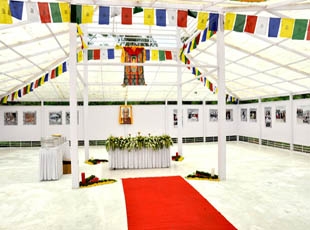 The Frenchman, who spent many years as journalist and reporter in India, wrote books on Indian history. His “A New History of India” was an attempt to rewrite Indian history as it happened and not as it has been written by the western scholars and historians and adopted blindly by their Indian counterparts.
The Frenchman, who spent many years as journalist and reporter in India, wrote books on Indian history. His “A New History of India” was an attempt to rewrite Indian history as it happened and not as it has been written by the western scholars and historians and adopted blindly by their Indian counterparts.
After the success of this book, Gautier felt the necessity of a museum and when he was honored with the prestigious Nachiketa Award in journalism by the then Prime Minister of India he used that fund to start a foundation called FACT- Foundation Against Continuing Terrorism.
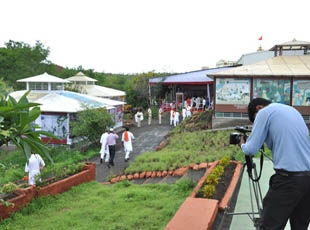 The first exhibition brought out by FACT was on ‘Genocide and Exodus of Hindus in Kashmir’ which Gautier witnessed ‘firsthand being a reporter for Le Figaro at that time’.
The first exhibition brought out by FACT was on ‘Genocide and Exodus of Hindus in Kashmir’ which Gautier witnessed ‘firsthand being a reporter for Le Figaro at that time’.
This was soon followed by another exhibition on the “Plight of Minorities in Bangladesh”; Aurangzeb ‘According to his own Records’; ‘Hindu tolerance throughout the Ages’ and so on.
A couple of years ago he developed an idea of starting a museum of TRUE Indian history on the five acre land donated by HH Sri Sri Ravi Shankar and the first phase was completed on time. The first phase of FACT Museum was inaugurated by Sri Sri Ravi Shankar, Sri Nitin Gadkari and Sri Ajit Pawar.
The museum houses an exquisite Bhavani Bharat temple which is the second such shrine dedicated to Mother India—the first being at Hardwar set up Swami Satyamitranand Giri Maharaj. In fact, by creating a shrine in the name of Mother India, Gautier has fulfilled the century-old wishes of Sri Aurobindo and Lokmanya Tilak to have such a temple of Mother India in Maharashtra.
They later inaugurated three exhibitions: a miniature painting exhibition on Chhatrapati Shivaji Maharaj, an exhibition on Hindu Tolerance Throughout the Ages, and the one that proved scientifically that the famous Aryan invasion never occurred.
In his blessings Sri Sri Ravishankar, describing Chhatrapati Shivaji Maharaj as ‘light that emerged in Maharashtra’ and, a ‘right combination of perfection in politics and the epitome of spiritual values’, said tolerance, broad vision and good governance were his gift to the people of India.
Once again today, India was in such a place where it needed leaders like Chhatrapati Shivaji Maharaj—the leaders with commitment to its people and a long term vision for the country. He congratulated Francois and his wife Namrata for rekindling the spirit of Chhatrapati Shivaji Maharaj.
At the entrance of the museum a shrine dedicated to Mata Bhavani and Chhatrapati Shivaji welcomes the visitors. The museum has halls, video room, and buildings to permanently arrange the various exhibitions. The video room has films like “Brahmins have become the Dalits of India” or a film of testimonies of survivors of terror attacks in Mumbai of 26/11.
The fourth building that was completed recently now houses the exhibition on genocide of “Tibetans at the hands of Chinese”. The Tibetan Spiritual leader Dalai Lama inaugurated the same on Sunday, July 28.
 The museum located near Marathwada Institute, Wadgaon Shinde Road, Wadgaon, Pune, is open every day from 9 am to 6 pm for the visitors with free entrance.
The museum located near Marathwada Institute, Wadgaon Shinde Road, Wadgaon, Pune, is open every day from 9 am to 6 pm for the visitors with free entrance.
Francois and his better half Namrata have embarked on a very noble yet equally difficult project. There is no tradition in India to support private museums unlike the West. Moreover the issue of Indian History is the trickiest and sensitive issue; and the most notable difficulty is to raise the funds. Both, with their undaunted zeal have taken up this challenge.
The FACT foundation undertakes awareness campaigns, conferences, exhibitions films and papers on Art, Culture, History, and Human Rights abuses. Fact India’s objective is to bring attention to these forgotten and neglected issues and to pressure the governments and international organizations to take corrective actions.
Why he selected Pune? Says Francois: “I came to Pune seven years ago, knowing about Shivaji Maharaj, having researched him for my books and being a long-standing admirer. I asked my driver to take me to the main museum here, which is called Kelkar. I was surprised and shocked to find that there was not a single exhibit on Shivaji. That day, the idea of a museum of Indian history, dedicated to Shivaji Maharaj started taking shape in my mind. Pune is also the ideal place, as Marathas have a stronger national fiber than in other states and I felt the museum will be better protected here”.

